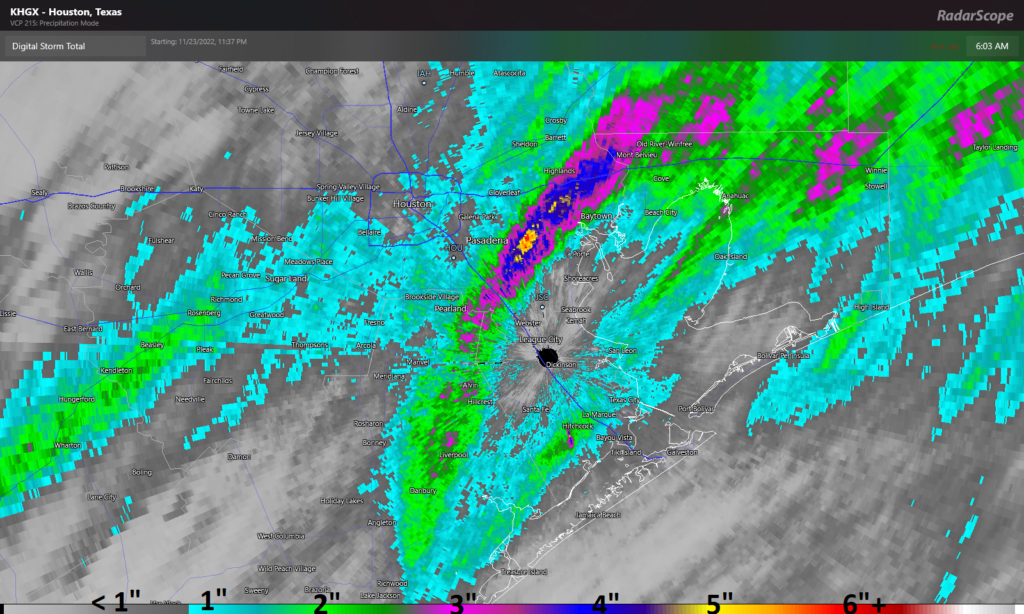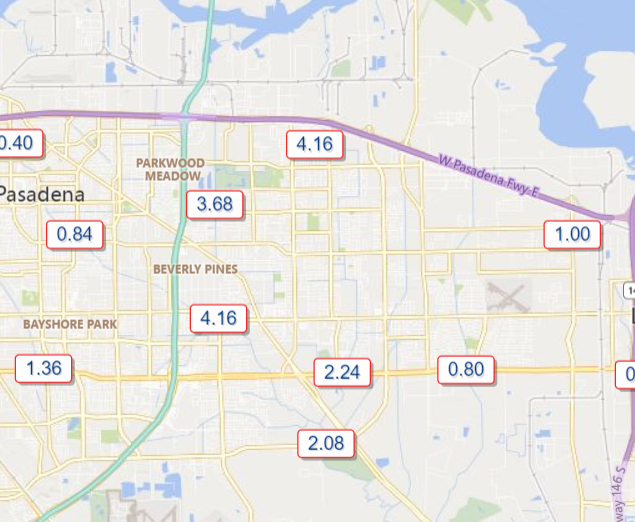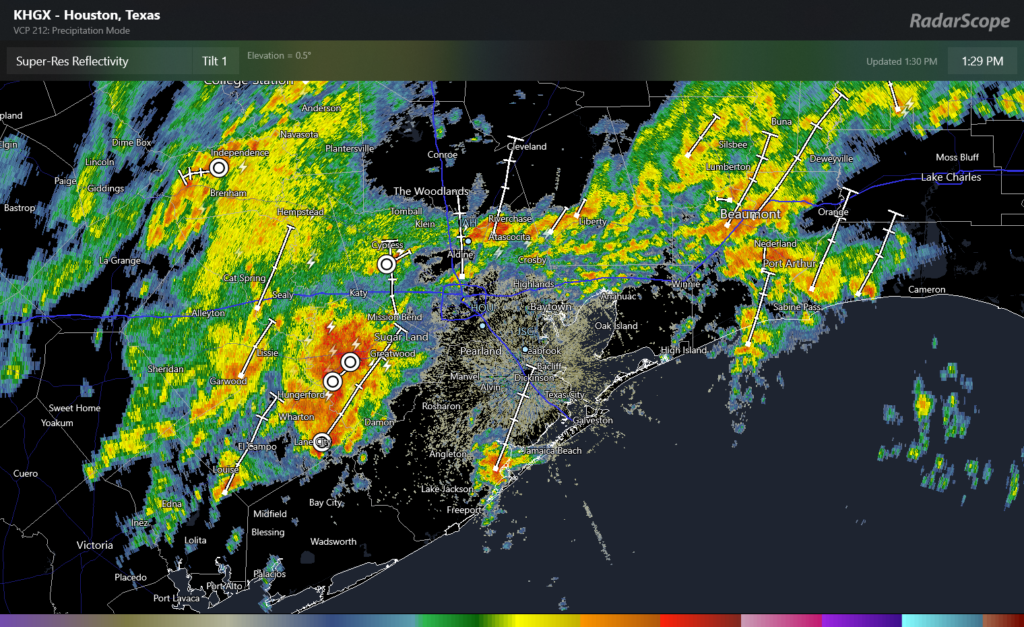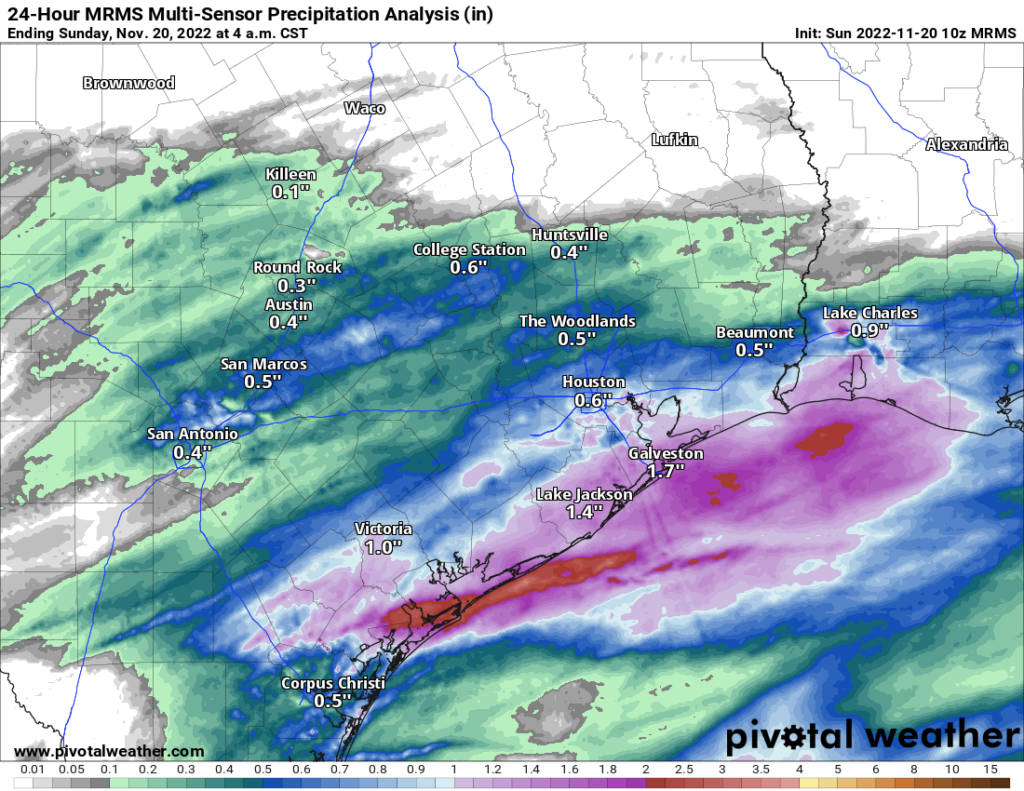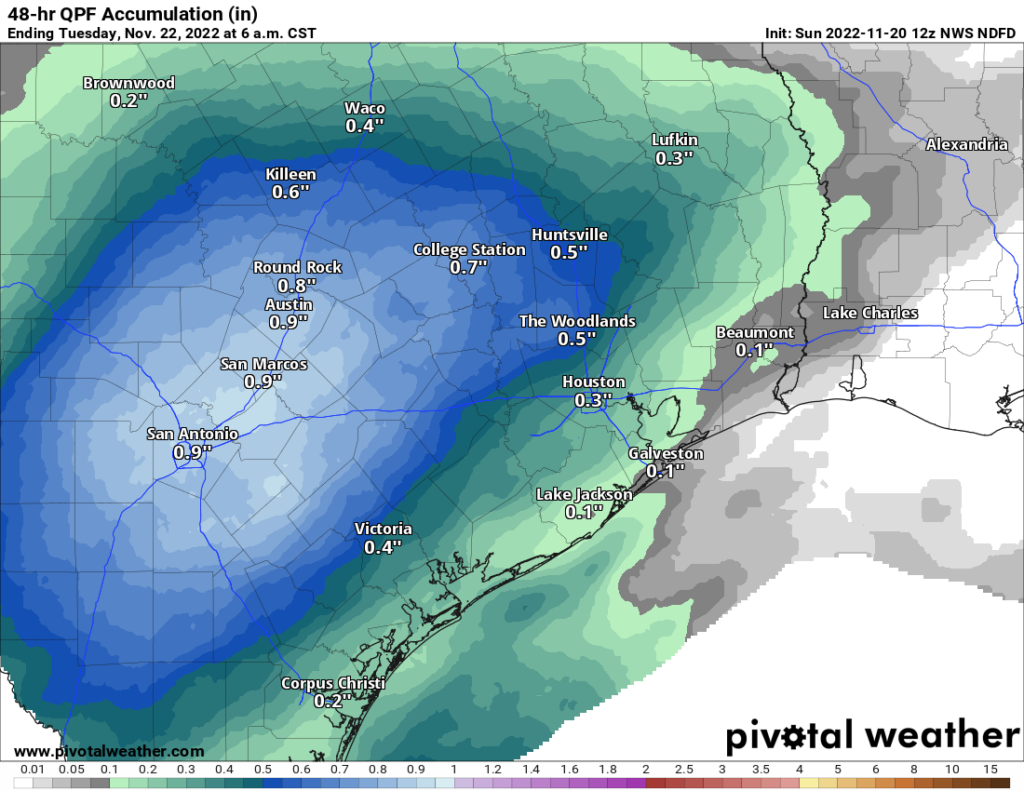Thursday saw clouds gradually take over our skies, a sign of the expected change that we’re beginning to feel this morning. Step outside, and it feels a bit different than 24 hours ago.
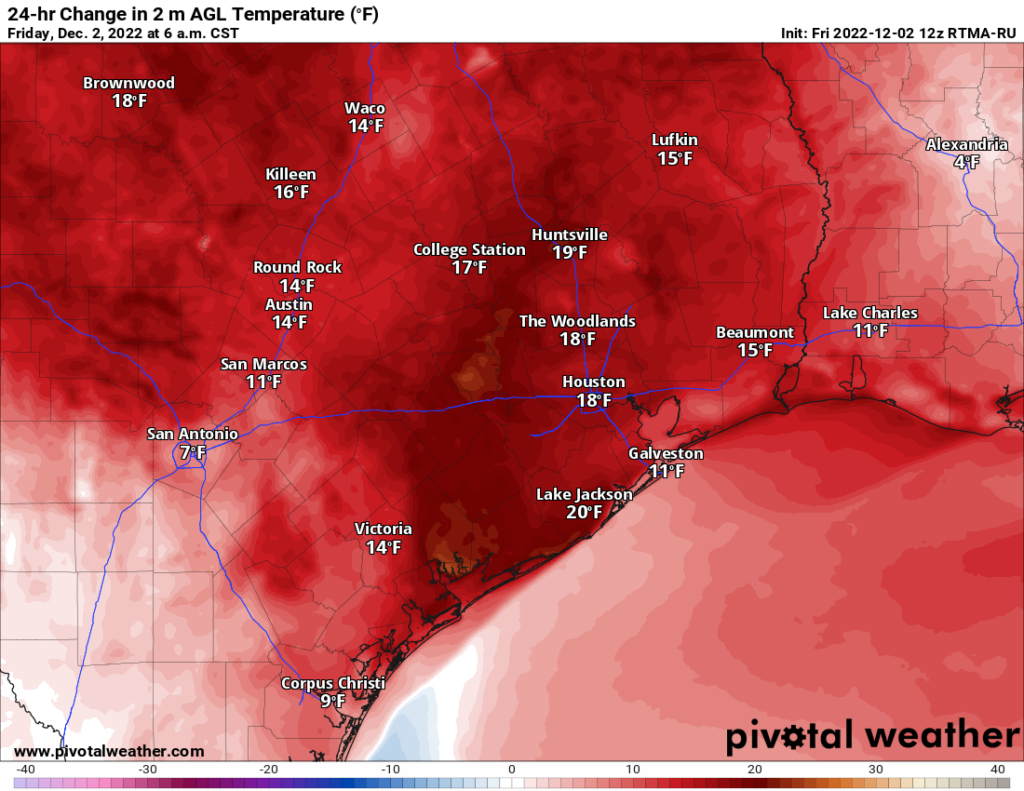
In fact, most parts of the Houston area are almost 20 degrees warmer than they were yesterday at the same time. This heralds our movement into a milder, more humid pattern that’s likely to stay with us with minimal interruption through next weekend.
Below today’s forecast, I’ve got the latest installment of the SCW Book Club, with some comments on The Worst Hard Time, by Timothy Egan.
Today
As the warm front delivering us the change in weather pushes north today, we can expect a few things to happen. First, a few showers or pockets of light rain and drizzle will be possible amid the cloud cover today. We already have a little of that this morning. Second, areas of fog are likely to begin forming along the coast by later this afternoon and evening. Watch for dense fog tonight in Galveston and elsewhere near the bays and coast. We’ll see temperatures soar into the mid-70s or better today.
Saturday & Sunday
The forecast gets a little challenging tomorrow. A cool front is going to push into far northwest parts of the region, and that means there will be some temperatures discrepancies. Places like Huntsville or College Station through Navasota could see temps fall from near 70 into the low-60s or even 50s later on Saturday afternoon. Houston and points south and east should not see the front until later Saturday, so expect highs well into the 70s again. Temperatures will drop into the 50s in parts of the area, while coastal areas stay in the 60s Saturday night, all of this contingent on exactly where the front gets before shifting into reverse. Basically, it might not be a bad plan to have a light jacket handy in case that front is a little faster than we expect, particularly if your plans will be north of I-10 on Saturday.
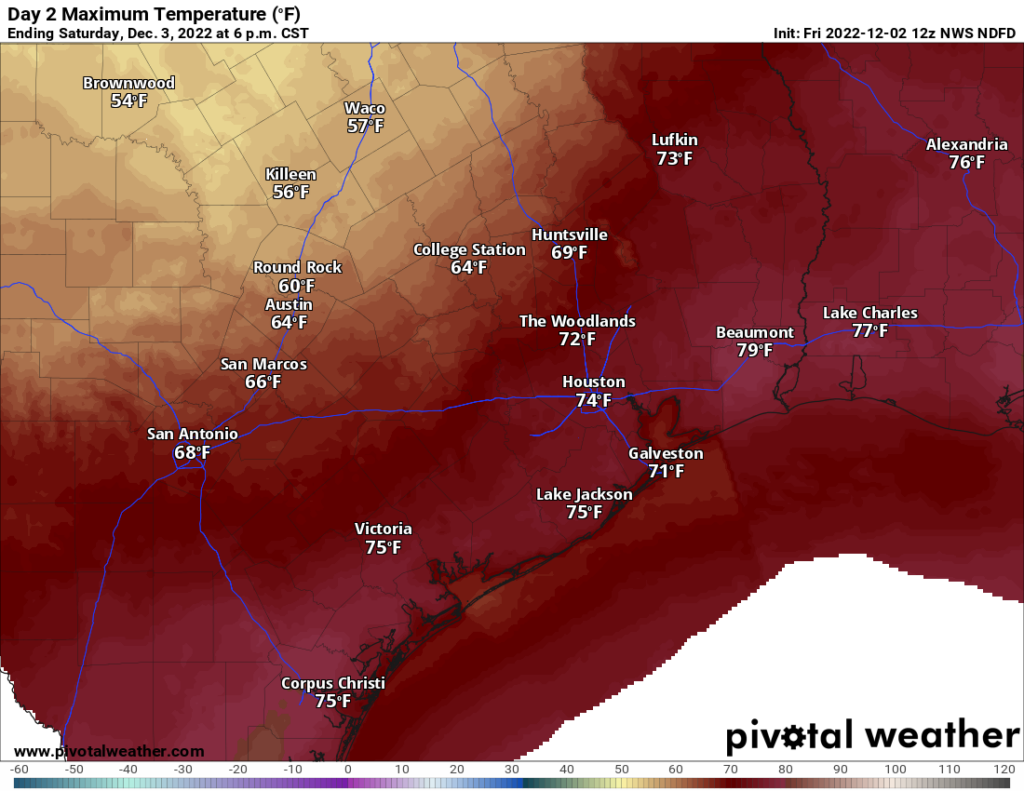
Other than clouds, fog will be an issue most of Saturday along the coast and bays and just inland from there. December is the second most likely month of the year for dense fog in the Houston area (behind only February). So, it’s that time of year. A few showers will be possible on Saturday as this front toys with us.
On Sunday, that front will start to lift back north and out of the area as a warm front, bringing back warm temperatures and humidity. We will have upper-60s or perhaps 70s again with clouds, patchy fog near the coast, and maybe a little sun. Maybe.
Monday through Wednesday
By Monday, we’ll be well back into a soupy air mass with high humidity and warm temperatures. Look for highs near 80 with clouds and a little sun, as well as a little coastal fog. Tuesday looks to be a repeat, if not a degree or two warmer. Wednesday? You guessed it; more of the same. All three days will have lows in the upper-60s to low-70s. They’ll also carry low-end shower chances, as the warm weather should keep the atmosphere fairly well “capped” I think, inhibiting showers and storms in our area.
Late next week
At this point, Thursday and Friday look fairly similar to the front part of the week with upper-70s to low-80s, clouds, and a slight shower chance. Areas of fog may be more widespread later in the week, however. As of now, let’s pencil in the next cold front for Saturday. Could be a bit faster or slower. This front may usher in a little bit of a lengthier cool spell for the week of the 12th, so for those of you who don’t like seeing 80s in December, there is hope. We’ll have more on that next week.
SCW book club
Back in spring, we started a concept called “SCW Book Club.” For those that follow me (Matt) on Twitter, you know I read a lot. Or I try to. With two toddlers that is becoming increasingly challenging! The premise of SCW book club was that anytime a weather or disaster-related item of interest entered my reading stack, I’d share some thoughts on it with all of you. In March, I reviewed Rachel Kimbro’s excellent In Too Deep about why people rebuild after repeated flooding. I said I’d get to The Worst Hard Time, by Timothy Egan, a book about the Dust Bowl. I did, but I did not get to it “later this spring.” Whatever the case, I finally finished it last weekend! And I can truly say it’s a must-read.
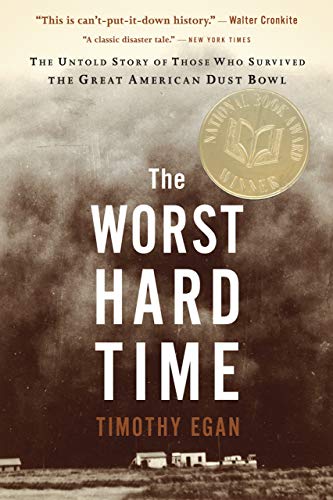
It was published in the mid-2000s and won the 2006 National Book Award for non-fiction. I approach books like this cautiously because I know they’re well-regarded for a reason. For some reason, The Johnstown Flood, by David McCullough, another of those seminal disaster narratives did not hook me as much as I had hoped. It was fascinating and enjoyable, but something about it left me wanting (I have three books by McCullough on my nightstand at present though, so I will definitely be giving him another go in ’23). The Worst Hard Time lived up to the hype.
The book does such a good job telling the story of the Dust Bowl through the lens of various residents of the High Plains. Egan’s writing captures you immediately. There were moments where it was tough to put the book down. Some books about disasters can be academic in a sense; this is not that at all.
“The land around them was tossed about and dusted over, as lifeless as the pockmarked fields of France after years of trench warfare.”
For someone like me, this book was nearly perfect. It covers the history of a major American event, a weather-influenced event. Egan went into detail about how FDR planned to help solve the issue, so it included the “politics” of the day as well. Ultimately, the story of the Dust Bowl is so terribly nuanced that even for someone that knows a good bit about what happened, it can surprise you. Between learning how many people were sold a lie, then doing what they had to do to survive and destroying the land in the process, the Dust Bowl was even less a truly “natural” disaster than I ever believed.
If you want to truly understand the Dust Bowl and what people lived through in that part of the country during that time, this is your book. If you’ve read the book, please drop some comments and share your thoughts below. I’ll be keeping tabs on them.
The next weather book I am going to get to is a book called F5: Devastation, Survival, and the Most Violent Tornado Outbreak of the 20th Century, by Mark Levine (not to be confused with political commentator Mark Levin). This book recounts the April 1974 “Super Outbreak” of tornadoes that swept across a large part of the Eastern U.S. This book is tough to find, so if you’re fortunate to grab a copy and want to read it too, feel free. I actually stumbled onto my copy at Kaboom Books in Woodland Heights, which is a delight if you ever have time.
After that, I intend to read a book entitled Air Apparent, by Mark Monmonier which traces the history of the weather map. I imagine many of our readers might enjoy this one. This is also somewhat difficult to track down, but some used copies are available over on bookshop.org. I’m looking forward to this one. Look for something on that after the holidays.
